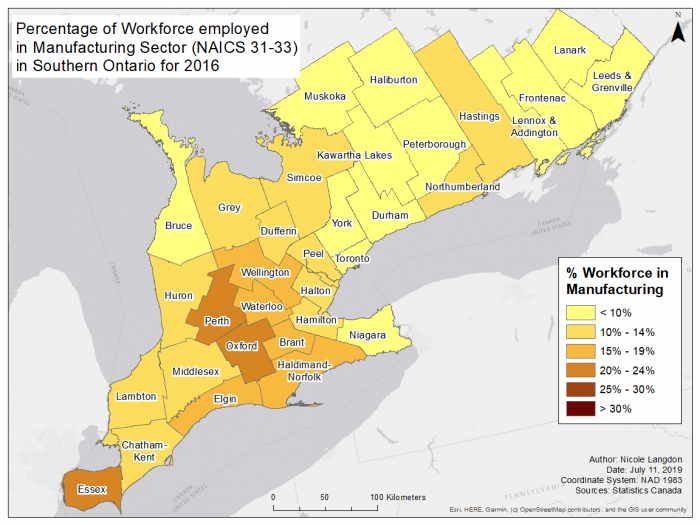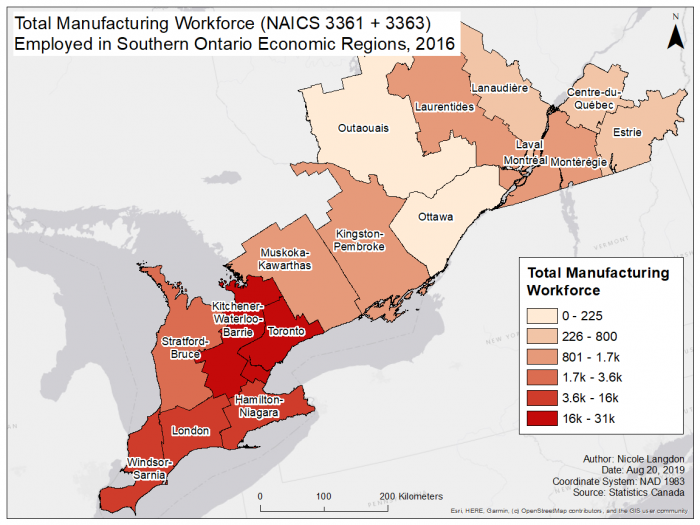This past summer I had the pleasure of working with a professor from McMaster University’s Labour Studies Department to map the labour sheds of manufacturing workers in populous parts of Canada. The intersection of a shrinking manufacturing sector, higher commute times, stagnating wages, and increased housing costs makes for a rich discussion of the ways in which manufacturing workers negotiate where they live and work.
We were interested specifically in car and parts manufacturing (NAICS codes 3361 and 3363, respectively). Our study area was threefold: Southern Ontario, South-Western Quebec, and South-Eastern Manitoba, with a particularly strong focus in Ontario. These are the sites at which almost all parts and car manufacturing take place in Canada, and the surrounding areas constitute their labour pools. The research questions we had in mind going forward were:
- What does the manufacturing landscape look like in Canada?
- What are the commuting patterns of manufacturing employees, and are they different from the general workforce?
- Are the commute times of manufacturing workers significantly different from the general workforce?
This project is still ongoing. Thus far, much of the literature on commuting in Canada is focused on the inter-provincial level, and finding research on how commuting impacts manufacturing employees specifically is difficult.
In order to get a better understanding of the manufacturing landscape, we began by collecting municipal documents from various cities in Southern Ontario to see how they were dealing with the chronic offshoring of manufacturing jobs from North America. Their experiences were fairly uniform; an aging population, shrinking manufacturing sector, and rising costs of living were all making the retention of manufacturing in their municipality an ongoing challenge. For places where manufacturing provided the backbone of their local economy, the changing job market was an especially acute hardship. Most solutions proposed focused on giving economic incentives for manufacturing plants and transitioning their labour base towards “advanced” and more specialized forms of manufacturing, such as those involving computer technologies and automation equipment. Additionally, several municipalities expressed a need for more in-depth data about the commuting patterns of their workforce. While Statistics Canada collects these data, they are not easily accessible for confidentiality reasons.
Using this as a launching-off point, we began by mapping the percentage of people employed in manufacturing and compared the 2001 census data to the 2016 census data in order to get a clear picture of where and how manufacturing hotspots have moved across Southern Ontario (where manufacturing is most concentrated in Canada, even compared to the other regions in our study area).
From there, we combed through Statistics Canada data on modes of commuting and found that manufacturing workers were more likely to drive to work than the general workforce across every economic region in our study area, even when mass public transit was available (such as in Toronto). We also found that, as urban population increases, the overall number of manufacturing workers decrease.
This could be because of high land values pushing out plants, the high cost of living preventing people from living on a manufacturing wage, or the overall shrinking relevance of manufacturing work in the Canadian economy.
Then, we wanted to investigate whether or not these manufacturing workers lived close to their place of employment. While the majority of them did in Southern Ontario and South-Western Quebec, our study area in Manitoba showed that Winnipeg has a more self-contained labour shed, with most of the manufacturing workforce choosing to live close to their place of work.
Note: only vehicle manufacturing (NAICS 3361) is shown here for the sake of saving space and readability, as the maps for it and parts manufacturing (3363) are fairly similar.
Additionally, we see that in areas with a low percentage of workers living and working in the same economic region, they also have a lower manufacturing workforce overall. This suggests that manufacturing work mainly pulls from the local labour force, especially when the work promises lower wages. This was echoed in the small amount of literature we did find – the periphery-to-core model was not an accurate reflection of reality, as most rural workers lived rurally, and urban workers lived in urban centres.
The next step will be to do some commuting pattern analysis on manufacturing workers to understand how and where exactly they commute from, and if they have unique commuting challenges compared to Canada’s general workforce. The goal is to understand how these patterns are emblematic of larger social issues, such as the prohibitive cost of living in urban centres and increased traffic congestion. With this, we hope to gain a more nuanced understanding of how deindustrialization and job offshoring is impacting Canadian workers beyond simple and direct costs of loss of employment.






